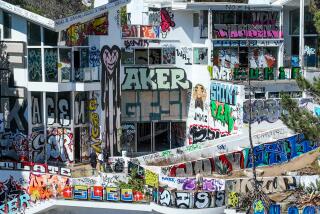Sought-after Cameron Woods finally feeling the real estate crash
- Share via
It is, quietly, the talk of the street. And in the San Fernando Valley, this is not just any street.
It’s a quarter-mile stretch of Orion Avenue in Van Nuys known as Cameron Woods. But location scouts, and just about everyone else, call it the “Leave It to Beaver” block, an anomaly of spacious New Englands and Cape Cods nestled inside a grittier suburb.
Homes here used to be snapped up before listings ever went public, often by the children of other Orion Avenue residents. For decades its white picket fences and rolling emerald lawns have made it one of the most filmed streets in Los Angeles, standing in as a vision of Anywhere, U.S.A., in movies, television shows and commercials.
But time, and the biggest economic tumble since the Depression, has caught up with Cameron Woods.
In a sign as good as any of how tough the real estate market remains, one of the street’s oldest homes sports peeling paint and thigh-high weeds, along with a “For Sale” sign. It’s been empty for two years and on the market for nearly a year.
Neighbors gathering in knots on the street whisper about the possibility that the home, which hasn’t been updated since it was built in 1949, could signal the beginning of real change on a street that has changed little in 60 years.
“We’re concerned that if someone doesn’t rescue it soon, it could become a tear-down,” said Susan Amedeo, who for 35 years has lived in a white and red-brick cottage across the street. “This is a glorious place to live, and the film companies still come calling every week. But we’ve had a different economy.”
Cameron Woods is a place of multi-generational families and people looking out for each other. If an elderly resident is in need, help is only a neighbor away, whether it is paying a bill or doing maintenance.
Every fall, the folks hold a potluck block party and bring in a bounce house for the street’s youngest generation. They trade gardening tips (white iceberg roses are most reliable) and strategies for capturing the film industry’s sometimes fickle attention (“Got a palm tree? Cut it down”). After all, some location shoots can bring upward of $4,000.
“It’s like being the prettiest girl in the class. How are they going to vote?” Amedeo said.
The street’s back lot ready appeal keeps Orion in demand, said Todd Lindgren of FilmLA, which handles permits for the city. In 2009, 48 production permits were issued; last year, 36.
Other popular residential streets include Stansbury Avenue in Sherman Oaks, Windsor Square in Mid-City and, for that quintessential L.A. look, the boho chic of Venice. Orion fills the bill for the “I Like Ike” period of Americana, he said.
It helps that traffic is prevented from accessing the street from heavily traveled Victory Boulevard, creating a kind of gated community — without the gate.
For all the street’s visual charm, though, squabbles still occasionally pit neighbor against neighbor.
Bill Dennis, 65, who grew up in the house he now owns, recalls one family that tried to woo filmmakers by installing movable walls and countertops, the better to accommodate large cameras.
The cameras came. Neighbors got so upset by the frequent shoots, and lack of parking, that they formed a neighborhood association and wrote rules limiting filming to 14 days a year per house, he said. That family eventually moved out.
Now neighbors are fretting about the high weeds and disrepair of the house at 6216. For decades it was Maury and Arlene King’s place. The couple raised their children in the four-bedroom home. Maury died in 1994, and when Arlene passed away two years ago, the children decided to put the house on the market, said Realtor Julie Bate of Coldwell Banker, who has the listing.
For a while, the block was cheered by news that a young couple was buying the home. But in mid-May, their deal fell out of escrow.
“Unfortunately, there’s not a happy ending yet,” Bate said.
Bordered by Victory to the north and Erwin Street to the south, the 6200 block of Orion Avenue was the dream of developer William Bucher. He built most of the homes between 1946 and 1952 and, according to lore, had a Connecticut street in mind, leaving some of the walnut trees that had been there to spread their stout limbs along the street’s curving lines.
Until Bucher, few builders in the San Fernando Valley had tried putting big houses on even bigger lots. The 30 homes in Cameron Woods are built on lots roughly 100 feet wide by 300 feet deep, leaving plenty of room for grand manicured lawns and park-like gardens in the back.
Bucher’s plan to build a whole subdivision of estate homes evaporated when he and his partners had a falling out and the city changed the zoning, said Dennis, whose father, Robert, bought the family home in 1952 and designed it with Bucher’s help. On adjacent streets, much smaller tract homes, snapped up for a $1 down by WWII vets, were squeezed onto much smaller lots.
The block has remained a family-friendly respite from the congestion of surrounding streets, neighbors say. Amedeo, who bought her home in 1977, raised two daughters here and recalls summer days of children playing in the wide street until dark.
“At one time .... there were about 100 children on the street,” Amedeo said. “And we have three men who were raised on the street and then came back to live here.”
In the 1950s, Bill Dennis and his friends played ball in the street and took their fishing poles down to the Sepulveda Dam. In 1961, they rode their Schwinn bicycles to the top of Mulholland Drive and sped down the northbound lanes of the 405 Freeway a few days before the interstate officially opened, Dennis said.
World War II hero Audie Murphy lived in Amedeo’s home for a time, and “The Jack Benny Show” was written by Sam Perrin in an office behind another house. Character actress Kathleen Freeman, who played Peg’s mom in the “Married With Children” TV show, also lived here and threw fabulous Fourth of July parties, Amedeo said. Blues-rocker Bonnie Raitt, daughter of Broadway star John Raitt, spent her early childhood on the street.
And in 1999, a music video for the Dixie Chicks’ monster country hit “Ready to Run,” was filmed at two of the houses and made prominent use of the entire street’s white- and pastel-toned homes. “It was a scene where the three girls were dressed in wedding gowns, riding bicycles and were pursued by their fellas,” recalled Dennis, whose home was one of those used. “It was pretty wild.”
On a recent day, first director Chef Roussel was scouting a location for a commercial set to film the next day.
“I shot a dog food commercial there two weeks ago,” he said, pointing to a white clapboard home with black shutters. “And we’re shooting a paper towel spot here tomorrow. It’s a good place when you have a family product.”
Marilyn Mullins has had dozens of shoots at her home with its distinctive barn-style facade, including a brief “Transformers 3” scene and a segment of the now-canceled “HawthoRNe” TV medical drama. Commercials for Cutter Bug Spray, Special K cereal and a spot that had actors “flying” across her yard into her neighbor’s spring garden for Lowe’s are among those that feature the property.
She keeps track of each in a small ledger she keeps inside her home of shabby-chic perfection. A small blue sign perched near her door reads, “We welcome filming.”
Mullins’ husband, Keith, was critically injured in a head-on crash 13 years ago. After years of caring for him, she reluctantly put him in a nursing home. The income from film shoots supplements her pay running the gift shop at Valley Presbyterian Hospital, she said.
“To me, every one is a gift from God — really,” she said of the filming.
Mullins said the biggest change in her 40 years on the block was when the city in 2005 closed off access from Victory to cut down on commuters using the neighborhood as a shortcut to Sepulveda Boulevard. Now, time moves as slowly as Albin, a desert tortoise acquired three decades ago that still cruises her cavernous backyard.
Neighbors were taken aback by the “For Sale” sign at the King home, in part because it confirmed how far home values have fallen. Some of the nicest homes were valued close to $1 million at the height of the market in 2007; recent online estimates put values near the upper $600,000 range.
“Like everybody, we’ve taken a big hit over the past four or five years,” Dennis said.
In the last five years, only one home on the block has gone up for sale besides the Kings’; and in the last decade only five have changed hands. Yet the King house remains unsold.
Bate said she is re-listing the property at $499,999. Meanwhile, the neighbors wait.
“Sometimes we feel kind of insular here,” Dennis said. “Hopefully, we can keep it like that.”
catherine.saillant@latimes.com
More to Read
Sign up for Essential California
The most important California stories and recommendations in your inbox every morning.
You may occasionally receive promotional content from the Los Angeles Times.














